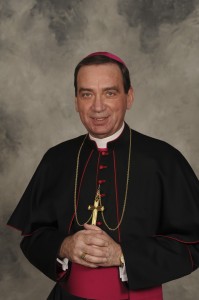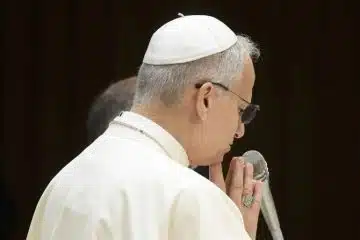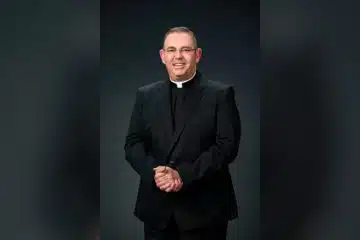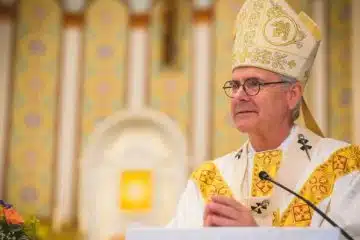Archbishop Dennis M. Schnurr celebrates 45th anniversary of Ordination.

On July 20, 1974 Archbishop Dennis M. Schnurr was ordained. Here is a reprint of the article announcing his appointment to the Archdiocese of Cincinnati.
WASHINGTON — Pope Benedict XVI has named Bishop Dennis M. Schnurr of Duluth, Minn., who is treasurer of the U.S. Conference of Catholic Bishops, as coadjutor archbishop of Cincinnati.
The appointment was announced Oct. 17 in Washington by Archbishop Pietro Sambi, apostolic nuncio to the United States.
Archbishop Daniel E. Pilarczyk, 74, is the current head of the archdiocese. As coadjutor, Archbishop Schnurr, 60, automatically becomes head of the archdiocese upon Archbishop Pilarczyk’s retirement or death.
Next year, on Aug. 12, Archbishop Pilarczyk will turn 75, the age at which bishops are required by church law to submit their resignations to the pope. The pope may or may not accept it at that time.
Archbishop Schnurr will celebrate what he called a Mass of welcome Dec. 7 at St. Peter in Chains Cathedral in Cincinnati.
The new coadjutor said he was humbled to be called by Pope Benedict to serve in Cincinnati.
“I have very big shoes to fill,” Archbishop Schnurr said during an Oct. 17 press conference at archdiocesan offices. “I know Archbishop Pilarczyk’s work. I know how thorough he is, and I look forward to being part of his administration.”
He acknowledged having much to learn about his new home. For the next several months, he plans to travel with Archbishop Pilarczyk to learn his way around the archdiocese.
On a lighter note, the new archbishop talked about his role in Cincinnati.
“There’s a joke about the difference between an auxiliary bishop and a coadjutor. Every day an auxiliary says to his bishop, ‘Good morning, Bishop.’ A coadjutor asks,
‘How are you feeling today, Bishop?’”
Archbishop Pilarczyk expressed his pleasure with Pope Benedict’s appointment at the press gathering. He said Archbishop Schnurr was at the top of his “very short list” of those he would want as a coadjutor.
Now that a coadjutor has been named, Archbishop Pilarczyk said he can begin to think more about retirement as well.
“For 26 years I have led the archdiocese and I am grateful for that,” he said. “But after 25, 26 years, one is inclined to get a little tired.”
At the same time Archbishop Pilarczyk offered advice to his fellow archbishop.
“One of the things I learned is not to micromanage,” he explained. “Give people a job, delegate, let them do the job. My advice to Archbishop Schnurr will be don’t try to do it all yourself.”
The new archbishop was ordained a bishop in 2001 after being appointed to lead the Diocese of Duluth by Pope John Paul II. From 1995 to 2001, he was general secretary of the National Conference of Catholic Bishops-U.S. Catholic Conference in Washington, now called the U.S. Conference of Catholic Bishops.
He also organized the 1993 World Youth Day in Denver, which brought Pope John Paul to the United States.
As Duluth’s bishop, he joined with his fellow episcopal leaders in Minnesota in 2002 to urge Congress to pass legislation protecting the country’s steelworkers and an unsuccessful effort in 2006 to amend the state’s constitution to define marriage as the union of one man and one woman.
A native of Hospers, Iowa, Archbishop Schnurr was ordained a priest for the Diocese of Sioux City, Iowa, in 1974. He studied for the priesthood at the Pontifical North American College and the Pontifical Gregorian University in Rome. In 1980, he earned a doctorate in canon law from The Catholic University of America in Washington.
In the Sioux City Diocese, he served in several parish assignments and as vice chancellor and chancellor. He was subsequently assigned to the staff of the apostolic nuncio in 1985 in Washington, where he gave advice on canon law, monitored financial affairs and researched issues of interest to the church.
Then-Father Schnurr joined the bishops’ conference in 1989 as associate general secretary and was elected general secretary in 1995. He played a major role shepherding efforts to combine the National Conference of Catholic Bishops and the U.S. Catholic Conference into the U.S. Conference of Catholic Bishops in 2001.
Archbishop Pilarczyk is one of the longest serving episcopal leaders in the U.S., having been appointed archbishop of Cincinnati Oct. 30, 1982. He also served as president of the U.S. bishops’ conference in 1989-92 and as vice president in 1986-89.
As head of the Cincinnati archdiocese, Archbishop Pilarczyk long has been an opponent of discrimination against homosexuals and people of color. The archbishop’s 1999 reflection for the Rev. Martin Luther King Jr. holiday rejected racism as “foreign to the mind of Christ.” In 1993, he opposed an amendment to the Cincinnati city charter that limited the civil rights of homosexuals in areas of housing, employment and public accommodation. The amendment ultimately passed, but was repealed by voters in 2004.
In 2003 in Hamilton County Common Pleas Court, Archbishop Pilarczyk took the unusual step of pleading no contest on behalf of the archdiocese to five misdemeanor counts and accepted responsibility for charges of failing to report sexual abuse involving priests and minors. The archdiocese was fined $10,000 for the violations, which occurred from 1978 to 1982 while then-Archbishop Joseph L. Bernardin headed the local church. The charges did not cite specific cases of abuse.
He subsequently established a $3 million fund to compensate victims abused as minors by clergy or other agents of the local church.
Archbishop Pilarczyk also is chairman of the Catholic Common Ground Initiative, which Cardinal Joseph L. Bernardin of Chicago launched shortly before his death in 1996 in an effort to end polarization in the U.S. church and bring reconciliation and healing.
A native of Dayton, Ohio, Archbishop Pilarczyk was named auxiliary bishop of Cincinnati in 1974 and named archbishop Nov. 2, 1982. He was ordained a priest of the archdiocese Dec. 20, 1959.
The Cincinnati archdiocese has almost 500,000 Catholics, covers 19 counties in southwest Ohio, and has 220 parishes and 113 primary and secondary schools.













